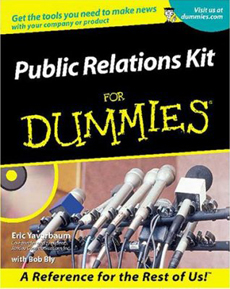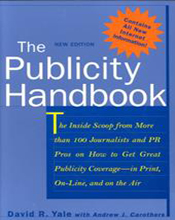
If you’re smart enough to realize you need PR, then you’re no dummy! (There’s more information about this book below.)
MEET THE AUTHOR |
LUCY SIEGEL is President & CEO of Bridge Worldwide, LLC, a New York City-based public relations firm with expertise in food public relations (www.bridgeny.com). Click here to contact Lucy.
|
July 2005
|
 |
Build Visibility & Your Bottom Line
With Public Relations
You Don’t Need a PR Agency to Start Making The News
Specialty food and gourmet products companies, no matter how large or small, can benefit greatly from the use of public relations to build a corporate reputation and create product demand. PR is one marketing tool that you can afford even if you are a small business owner. This article is intended as “food for thought” on how to put PR to work to help build your bottom line.
I. Strategy
Pursue Home Grown Efforts If You Can’t Afford Experts
There is a lot you can do yourself, if you have no budget to hire a PR firm or independent consultant. It will take some time to “learn the ropes” in the beginning, and, ongoing it will take a chunk of your time to do the necessary work. This article will help you understand the steps to take.
- Down the road, when you can afford to hire outside help, you may decide that your time is better spent doing what you do best, and leave PR to specialists.
- One interim solution is to hire an intern who is majoring in communications at a nearby college. The intern can gain experience at the same time (s)he puts classroom and textbook knowledge into action on your behalf.
Understand the Difference Between PR and Advertising
Public relations is the art of managing the way that information about an organization and its products is communicated to the various groups that are important to the organization: customers, potential customers, employees, the community, investors, and so on. Often, the term “public relations” is used to mean communication with journalists at newspapers, TV and radio stations, magazines, online sites, etc.
- While public relations encompasses much more than working with journalists, providing information to the media is one of the most important tools of PR.
- Media coverage of an organization carries a lot of weight and influence. Unlike ads, articles in the media are not controlled by the organization, they are developed by journalists who report about the organization independently. Positive media coverage is a “third party endorsement” of an organization or its products which is far more credible than an ad.
Goals for Communications are Vital
It’s crucial to set goals for PR. First, decide whom you are targeting:
- Are the customers you seek local, national or international? If your target is local, you can concentrate media relations efforts on local media.
- Do you want to connect with end purchasers, or just with wholesalers and distributors? If the latter, then trade magazines and business journalists should be your primary target.
- Are you targeting consumers directly, via online sales or direct marketing? In that case, consumer media coverage will give you the visibility you need.
- Should you concentrate on existing customers or potential new customers? They may or may not be reached by the same means and media.
In addition, decide what you want to communicate. Focus on the three or four most important messages you want to get across and repeat them constantly. Although you know your products and company inside out, others do not. If you try to communicate too many things, you have little chance of getting across any of the messages effectively.
II. Procedure
First Create a Budget for PR
Budget both time and money for PR. Some of your time is needed, even if you have staff members or a PR agency doing the day-to-day work. Then prioritize your PR activities to spend your budget money where it will have maximum impact.
Then Develop the Tools You Need
A press kit with factual—not promotional—background information on your company and your products is a must. This information should ideally be in a “media room” on your website, as well as on paper. It should include attractive photographs of your products. Food and related products should look appetizing. While a stark box shot may suffice for a buyer who needs to re-order, your photos should show your products at their best.
Understand the Media You’re Targeting
Become familiar with what kinds of editorial material each media outlet offers, and target the media with material that fits.
- Take a look at competitors’ media coverage to better understand the types of stories that include companies and products like yours. Then you can target the journalists who developed those stories.
- Remember, journalists need something new, different and interesting to justify to their editors why they should report on your company or products.
- It’s also crucial to provide information in a timely manner. For example, when you are announcing a new product, you’ve got built in “news” – but it will be old news and unusable if you wait months before announcing it to the media.
Stick to the Facts and Don’t be Too Promotional
Journalists don’t like being “sold” with overly promotional language. When you provide information to them, leave out the adjectives (“most delicious,” “heavenly tasting,” “most popular,” etc.). You should also have back-up research and sources for any claims you make about your products.
- In a news release about your product or your company, put the information in the context of industry trends. Journalists are more likely to cover trends than products.
Provide Samples of New Products
If your product can be sent to journalists to taste, or if it’s a gadget or tabletop product they can touch and feel, you have a better chance of media coverage than if you just send a news release about it. A personalized note from the company president with an attractively presented product sample will be well-received.
Announcing New Products is Not the Only Avenue to Media Coverage
You can also suggest story ideas to journalists that include your product. For example, if your products lend themselves to festive holiday occasions, you might suggest a story on entertaining with ease at the holidays, and provide your own tips and holiday recipes or decorating ideas using your product.
Make Yourself a Spokesperson for the Company
Participating as a speaker at industry events or in your community will build company visibility, which translates into product visibility. You can volunteer as a speaker simply by writing to the event organizer and suggesting a topic on which you can speak.
Re-Merchandise Your PR Results
Ask for permission post media coverage (or a link to it) on your website. Send copies of articles to customers and potential customers with a letter from you.
Lucy Siegel welcomes your suggestions for future topics that she can address on public relations. Click here to e-mail Lucy.
If you would like to share your own successful PR tips and techniques with other NIBBLE readers,to send thclick hereem to us.
To read more about building a successful PR program for your business, we suggest:

|







